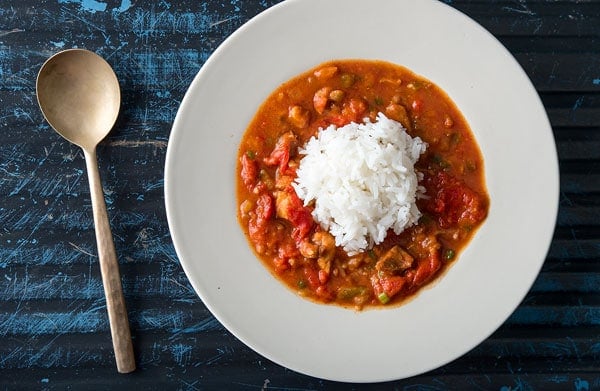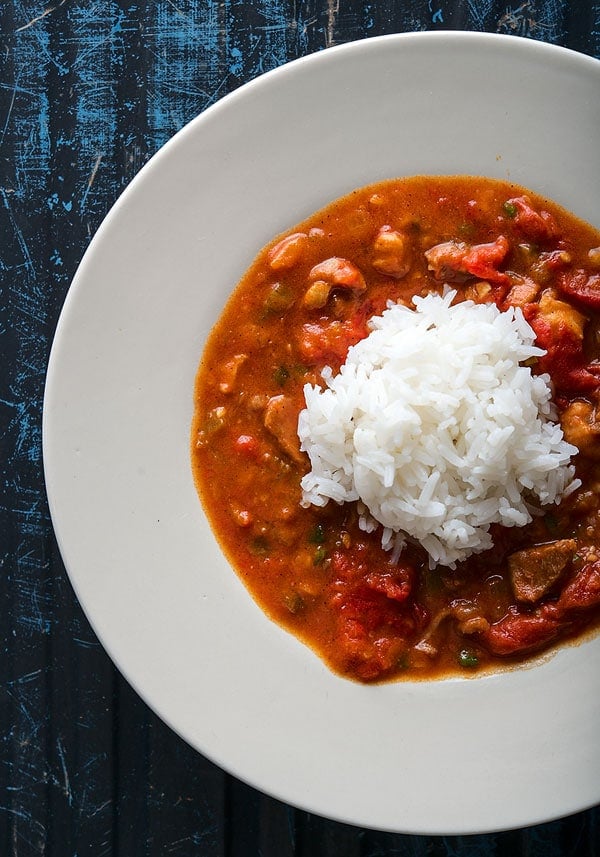As an Amazon Associate I earn from qualifying purchases.

This post is a long time in coming. More than a year ago, my friend Doctor Norm from Ohio randomly mailed me a dead, butchered snapping turtle — to this day, the weirdest, yet coolest thing I’ve ever received through the post. The first thing I made was Creole Turtle Soup, which is my favorite turtle recipe.
But it was a very big turtle. So I had enough for a second recipe. I thought about doing a Philadelphia terrapin soup, or a Maryland version of the same, but I was in the mood for “red food,” which, when you think about it, is what most of us crave when we need a little comfort; think spaghetti or chili or salsa or goulash.
That took me back to Cajun Country, where I’d eaten an outstanding alligator sauce piquante in 2013… or maybe it was 2012.
At any rate, I’d talked this recipe up ever since, and a number of Louisianans said it’s also great with snapping turtle. So here we go: snapping turtle sauce piquante.
A sauce piquante, pronounced pee-khant, is one of the few Cajun dishes I know of that commonly has tomato in it. Normally the presence or absence of tomato is one of the many things that defines the difference between Cajun and Creole. It hinges on a tomatoey, spicy sauce and meat that has been diced small.
This, incidentally, is a genius move with many tough creatures we who hunt and fish normally eat, as it makes them a) innocuous, and b) tender. (I have a great recipe for venison sauce piquante, too.)
Biggest difference between that recipe and this one is that turtle, being kinda-sorta “seafood,” gets a butter-based roux (my venison one uses peanut oil or lard) that is only cooked to the point it looks like peanut butter; my venison one uses a very dark roux. I also use white wine here instead of red.

Now I am perfectly aware that most of you aren’t going to dash out and trap yourself some snapping turtles to make this recipe — all though I salute those of you who are! — so know that you can make this recipe perfectly fine with chicken thighs.
But if you do get some turtle, it’s so much better. Why? Turtles have very varied meat. Some parts are light like chicken breast, some darker like pork, some almost beefy. The flavor is a meld of chicken thigh, pork, with a watery hint, too, a little like clam.
Trust me when I tell you it’s not at all off-putting or strong in the way that, say, eider or muskrat is… and yes, I’ve eaten them, too.
So give this turtle sauce piquante a go for your next party, even if you have to use the chicken thighs we normally use to bait snapping turtles.
Cajun Snapping Turtle Sauce Piquante
Ingredients
- 1/2 cup butter
- A heaping 1/2 cup all-purpose flour
- 2 cups chopped onion
- 1 cup chopped green pepper
- 1 cup chopped celery
- 5 garlic cloves
- One 6-ounce can of tomato paste
- 1 tablespoon Cajun seasoning, or more to taste
- 3 to 4 pounds turtle, alligator or frog meat, diced small
- 1 cup white wine
- One 28-ounce can tomato puree or crushed tomatoes
- 4 bay leaves
- Salt, black pepper and hot sauce to taste
- Chopped green onions or parsley for garnish
Instructions
- In a large, heavy pot like a Dutch oven, heat the butter over medium-high heat for a minute or two. Stir in the flour, then turn the heat down to medium. Cook this roux, stirring often, until it turns the color of peanut butter, about 10 to 15 minutes.
- While the roux is cooking, Heat 6 cups of water in another pot to the boiling point. Hold it at a simmer for now.
- When the roux is ready, add the onions, celery and green pepper and stir to combine. Turn the heat to medium-high and cook this, stirring often, until everything is soft, about 6 to 8 minutes. Sprinkle some salt over everything while you do this. Add the garlic, Cajun seasoning and tomato paste and stir to combine. Cook this, stirring occasionally, for 3 to 4 minutes.
- Mix in the turtle meat, then add the cup of white wine, the can of crushed tomatoes and the hot water, stirring as you add. Add the bay leaves and bring this to a gentle simmer. Add salt to taste. Let this simmer very gently until the meat is tender, at least 2 hours, maybe three.
- When the sauce piquante is ready, add any more salt, black pepper, hot sauce and/or Cajun seasoning you want, then serve it with white rice and lots of green onions or parsley. Make sure you have hot sauce at the table; I use Tabasco, but use whatever variety you prefer.
Notes
Nutrition
Nutrition information is automatically calculated, so should only be used as an approximation.






Wow. This is the taste of Louisiana. Turtle is my favorite meat, and I am an avid chef and hunter like Mr. Shaw. I give it an 11/10. This is one of those things that you lick the darn bowl after. I usually bread the turtle and deep fry it or make a white potato chowder with it, and those are 10/10 good, but this right here is just… piquant. No other word for it. Most piquant dish I’ve ever had!
Only thing I did different is use very hot jalapeño instead of bell pepper, and I halved the recepie because this turtle was a little smaller. It changed nothing about the flavor other than the spicyness, which I prefer. Other than that, it’s a winning classic French/Louisian recipe.
Check your local wildlife commission because some turtles do have seasons or cannot be harvested… but go stick a baited hook on a handline, bait it with some of meat, toss it into a ditch or pond. You’ll get a turtle, and you owe it to yourself to try this recipe. It is really that good.
11/10
My neighbor brought home a large common snapping turtle yesterday. I don’t know what his plans were before he talked to my son, but today the turtle met your recipe. Given its size, I believe he was part of my cohort and I wasn’t exactly enthusiastic about eating him (snapping turtles are unambiguous about their desire to go on living), but I have to admit this piquant was delicious. Thanks for having a recipe for everything.
Great recipe!!!
I have been catching turtles for a about ten years in Wisconsin and have always wondered. Is there anything you can do with the “caviar” Inside the turtle?
Mike, with softshell turtle, I like to eat the developing eggs raw with hot sauce.
Made this with Gator. I was delighted to have another way to enjoy this unique meat! 5 stars! Thank you Hank!
I butchered my first snapping turtle last year, and it was quite an experience to say the least! Google/You Tube is very helpful! I’m pretty sure that turtles are part zombie, because it didn’t quit moving till the very end! He was a big boy, so I put a ton of meat in my freezer and I’ve just been waiting for the right recipe to try it out on, and the right crowd to serve it to. I think I’m going to try your turtle soup recipe first, followed by this one. I also got rabbit meat from my friend’s farm recently, so I may use a combination.
Turtle butchering 101:
Cut head off turtle night before, rinse in very hot (boiling) water and scrub clean, refrigerate. Impale turtle shell-down on a spike of some sort that is secured to an immobile surface. Using a sharp(!!) knife, cut skin around legs, separating from shell. Separate top and bottom shell, discard bottom shell. Note that the turtle may still have some life left in it (reptilian nervous system is spread through body), so expect it to resist handling despite being headless; having the immobile spike to pull against facilitates skinning. Remove viscera, bone out legs, harvest meat from legs and shell. Will need experimentation and practice.
Here in London there are a number of large pet terrapins which have been released in public ponds when they’ve grown too big. They are not native and cause problems with the local wildlife. I believe there’s a large one in the Hampstead swimming pond that bites bathers! Thanks for a brilliant idea, but if I fail to catch one, I know where I can get hold of squirrel and frogs legs 😉
We have bazillions of snapping turtles here. I live on a pond that is perfect for them. I have to move a half dozen or so out of the driveway every year and usually a couple lay their eggs in my yard. I would have no idea how to harvest or clean one, though. And they STINK on the outside (like the bottom of a swamp, of course). Do you know how to clean them? Make a video!